Troughton London
Giant Double Frame
Brass Sextant/Quintant
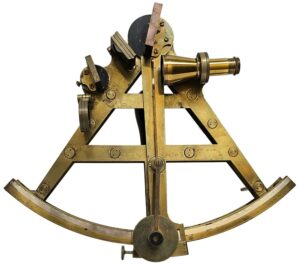
THE ORIGINAL TROUGHTON – LONDON
Giant Size Double Frame, Pillar Quintant/Sextant – only the second of these fine instruments we’ve carried.
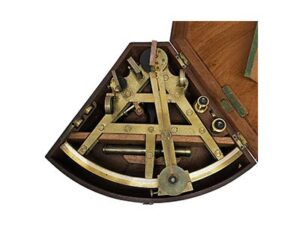
TROUGHTON & SIMMS were the
best of the English instrument makers. This instrument dates from before their partnership. It belongs in a collection
of fine nautical antiques or as an important gift
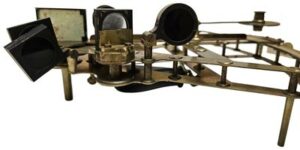 |
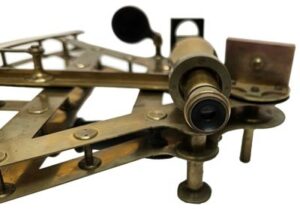 |
Presented is the second one of the largest double-frame sextants that we’ve had the pleasure to offer. They are rarely seen in reference works, museums, or any place. And to make it even more special, it was made by Edward Troughton when he was in business as a sole proprietor or perhaps when he and his brother John worked together. The frame is engraved Troughton – London and carries serial number 292, which indicates an earlier date than the last one we had several years ago numbered 1110.
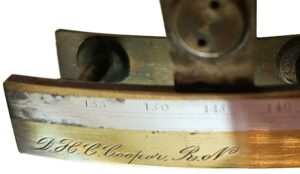 |
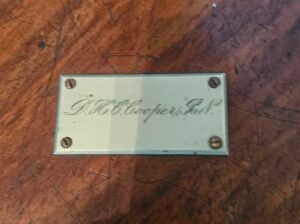 |
D.H.C Cooper, R.N. Engraved on the left end of the arc and top of the case
Given its age, we believe this important instrument has been with a few different owners. The personal name on the left edge of the arc and the engraved plate on the top of the case is D.H.C. Cooper, R.N. On the base of the index arm is engraved Capt. Western. The National Physical Laboratories examination certificate is dated November 1911.
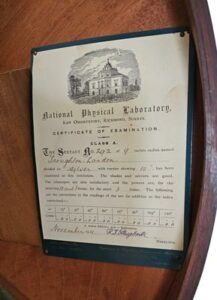
CERTIFICATE: National Physical Laboratory, Kew Observatory, Richmond, Surrey.
Dated November 1911.
This fine instrument is much larger than the normal size for
an instrument of this design, which suggests it was one of the first double-framed sextants made by Edward who invented this
design. Based on the work of Alan N. Stimson of the National Maritime Museum at Greenwich, England in 1976, we date it to Ca 1816.
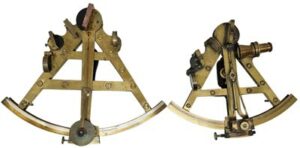
Comparison of the two sizes with our Troughton on the left
It measures approximately one inch more in all dimensions except for the size of
the mirrors which makes it 22 percent larger in area. The photo above shows the comparison of this instrument (on the left) next to a classic-size sextant.
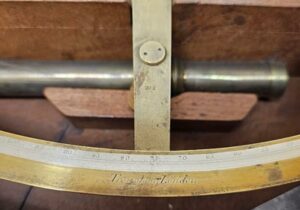 |
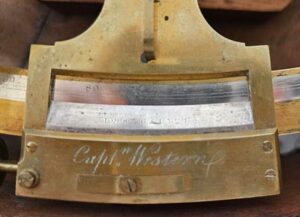 |
Maker’s mark, Troughton – London with serial number, 292, on vertical brace above and the engraved “Capt. Western” on the index arm
The arc subtends
an angle of -05 to 155 degrees which classifies it as a quintant. Since brass is much stronger and more rigid than wood, it became
the material of choice for sighting instruments. Double-frame sextants were expensive to make and never
gained the popularity of the more common single, cast-framed instruments. Consequently, they less frequently come to market.
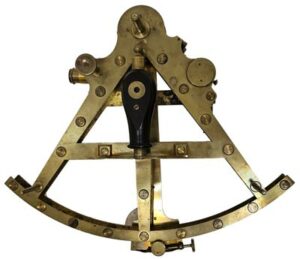
Backside View
This instrument is so rare and special that it can be considered a remarkable vestige
of the last quarter of the 18th Century.
DIMENSIONS: Arc -5° to + 155°:
Length of index arm 11 3/4″
Radius of arc 10 1/2″
Width of frame at arc 14″
Index mirror 48 x 32 mm
Horizon mirror 26 x 27 mm ellipse (cloudy)
3 index shades 3 horizon shades
Weight 3 Lbs 12 oz Case Measures: 16″ x 13″ x 5 1/2″
The sextant has a
brass straight-bar pattern pillar frame, mounted with twenty-one pillars over a second frame with various
fittings and mounts, and a wooden handle. The tangent screw and clamping screw are positioned on the back of the index arm.
The device has three index shades and three horizon shades. The telescope is attached to a perpendicular rising-piece
which is adjusted in and out by a milled knob. There is also a magnifier traveling over the vernier. There are 5 telescopes
present and three attachable lenses. The brass limb is inlaid with a sterling scale from -5° to 155° divided each 5 degrees.
The sterling vernier measures from right to left from 0 to 10 in arc seconds. Edward Troughton patented
the pillar and plate frame sighting instrument in 1788. This is a one-time opportunity to acquire an extremely rare and very large example of a double-frame, pillar, instrument from Troughton, the inventor of the design and without a doubt, one of England’s
most distinguished instrument makers!
INSTRUMENT CONDITION: Both mirrors show as cloudy with some corrosion.
The swing arm magnifier is complete and in good working order. Both sets of shades,
i.e., filters are without imperfections. The endless tangent screw turns freely. The brass finish shows a pleasant patina. There are five scopes with some lens filters included. The case is in good condition with a fine finish and engraved brass nameplate
 |
 |
HISTORIC BACKGROUND: Edward Troughton, FRS (October 1753 –
12 June 1835) was a British instrument maker who was notable for making telescopes and other astronomical instruments.
Troughton was born in Corney, Cumberland. In 1779, after serving
an apprenticeship with his elder brother John, he became his partner and soon established himself as the top maker of navigational,
surveying, and astronomical instruments in Britain. In 1795 he delivered the Troughton Equatorial Telescope
to the Armagh Observatory, a 2-inch aperture refractor telescope mounted equatorially, and its first major instrument since
its founding in 1790 (It survived into the 21st century also). [2] He created the Groombridge Transit Circle in 1806, which
Stephen Groombridge used to compile his star cataloger.[3] He did not merely build instruments, but designed and invented
new ones such as his double-frame instrument of 1788. Troughton was awarded the Copley Medal of the Royal
Society in 1809. He was elected a Fellow of the Royal Society in March 1810. In
1826, after John’s death and in failing health himself, he took on William Simms as a partner and the firm became known
as Troughton & Simms. Troughton was color blind. On his death in 1835, he was buried in Kensal Green Cemetery.
TROUGHTON & SIMMS,
THE SUCCESSOR: Troughton & Simms was a British
instrument-making firm, formed when Edward Troughton in his old age took on William Simms as a partner in 1826. It became a limited company in 1915, and in 1922, it merged with T. Cooke & Sons to form Cooke, Troughton & Simms. The firm produced
hundreds of astronomical instruments such as mural circles, transit circles, sextants, and other astronomical instruments
for observatories around the world. Previously, Troughton had
been a sole proprietor, and before that, he was in partnership with his brother John. John died and Edward took on Simms in
1826. Edward Troughton died in 1835. In 1924 the
company became a wholly owned subsidiary of Vickers; it continued in the instrument business until 1988. Refs. This maker
is listed in “Sextants at Greenwich” by W.E.J. Mozer Bruyns, which
catalogs the collection of the British National Maritime Museum at Greenwich, England. And in The Influence of the Royal Observatory at Greenwich upon the Design of 17th and 18th Century Angle-measuring Instruments at Sea”, 20 Vistas in Astronomy, 123-130 (1976),
Alan N.Stimson of the National Maritime Museum at Greenwich, England.
